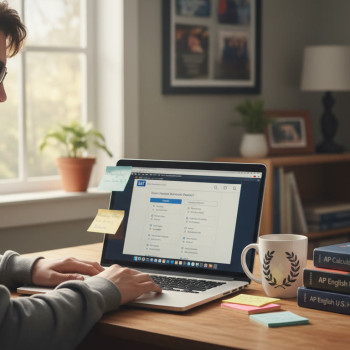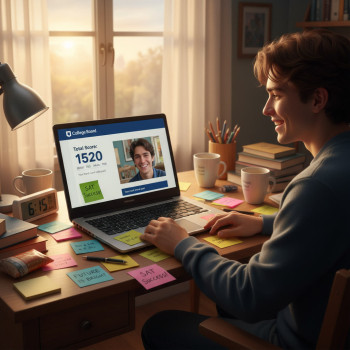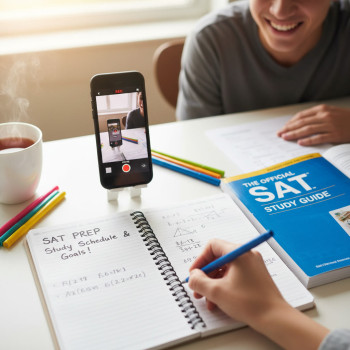Why practice tests matter more than ever for the Digital SAT
If you’re reading this in the last few weeks before the Digital SAT, first: deep breath. You’ve already done the long grind of learning content — grammar rules, algebra tricks, and close reading — and now you need to turn that knowledge into reliable performance. That’s where practice tests come in. They aren’t just for checking answers. Done smartly, they are the fastest way to discover weak spots, build stamina, and simulate test conditions so that nothing on test day feels like a surprise.
The digital SAT isn’t simply a paper test translated to a screen. The testing platform, timing blocks, and question flow create a different rhythm. Full-length, timed practice in the same environment (or as close as possible) helps you adapt to that rhythm and tune the strategies you’ll rely on when it matters.
How to choose the right practice test for this stretch
Not all practice tests are created equal when you’re close to test day. Pick versions that mirror the format you’ll encounter — digital, adaptive practice in the official testing app is best. If that’s not possible, use official downloadable tests but make sure you simulate the digital experience as much as you can.
- Prioritize official, full-length practice tests over third-party mock exams when possible.
- Use at least one practice test on the digital testing app (or an accurate simulator) to get comfortable with navigation, built-in tools, and the look of questions on screen.
- Reserve lower-quality or quick-question sets for focused skill sharpening (e.g., 20-minute grammar drills).
Photo Idea : A student sitting at a laptop taking a timed practice test on a quiet desk, headphones on, with a printed timing sheet and a calculator next to them.
The three phases of using practice tests in the final weeks
Think of the last 4–6 weeks before your Digital SAT as three distinct phases: baseline, focused improvement, and final rehearsal. Each phase has a different goal and a different way to use practice tests.
Phase 1 — Baseline (4–6 weeks out)
Purpose: Find where you stand and what matters most.
- Take one full-length, strictly timed practice test under realistic conditions. No phone. Same start time you’ll have on test day if possible.
- Record everything: time per section, how many questions you left, and your gut feeling about which questions felt hardest.
- Score it honestly and identify the top 3 problem areas (content, timing, or test-taking strategy).
Phase 2 — Focused improvement (2–4 weeks out)
Purpose: Improve targeted weaknesses while keeping your overall test timing in check.
- Use shorter, targeted practice sessions to drill the weaknesses you discovered in Phase 1 — for example, calculator-free algebra practice or pacing exercises for the Reading & Writing sections.
- Schedule two full-length practice tests in this window. After each test, do a careful error analysis (more on that below).
- Mix in one low-pressure timed run where you intentionally practice slower, solving problems with an eye on accuracy rather than speed; this builds confidence in your methods.
Phase 3 — Final rehearsal (last 1–2 weeks)
Purpose: Simulate test day and lock in routines.
- Take one final full-length digital practice test about 3–7 days before the real test. Make it as close to test-day conditions as possible.
- In the last two days, don’t cram new material. Do short, relaxing review sessions and a couple of light question sets to keep your brain active without creating fatigue.
- Finalize logistics: device readiness, Bluebook app checks, what you’ll eat, and how you’ll get to the test site (or set up your testing space).
How to simulate test day correctly
Simulation isn’t just about timing — it’s about the whole experience. Here’s how to make a practice test feel like the real thing so you get useful data from it.
- Use the same device type you’ll use on test day if possible (laptop, tablet). Install and practice in the official app before test day to learn navigation and tools.
- Follow the exact timing structure: when the clock runs, when you can move between sections, and when calculators are allowed.
- Recreate environmental conditions: desk set-up, lighting, and a 3–4 hour uninterrupted block. Practice with the same snacks and water you plan to use on test day.
- Wear the clothes you’ll wear so you’re comfortable with pockets, sleeves, or anything that might affect focus.
The step-by-step error analysis that actually helps you improve
Taking practice tests without analyzing them is like running races and never looking at the finish line times. A disciplined, written error analysis is where most score gains come from.
- Step 1 — Triage: For each missed question, label it as one of: careless error, content gap, timing/pacing issue, or misread question.
- Step 2 — Pattern check: Are most of your errors concentrated in one content area (e.g., linear equations, sentence placement) or across sections? Prioritize the clusters.
- Step 3 — Fix and practice: For a content gap, review the concept and immediately do 10–15 targeted problems. For careless errors, look for avoidable habits (rushing, skipping diagrams) and create a micro-strategy (e.g., always underline the question’s verb).
- Step 4 — Re-test: Put the same type of question into the next study block and track whether the error repeats.
Timing strategies and small habits that save minutes
On the Digital SAT, time management is less about being the fastest and more about being predictably paced. Here are simple habits to develop in practice tests that pay big dividends on test day.
- Use a two-pass approach. First pass: answer all questions you can with confidence. Second pass: return to tougher questions with a fresh timer.
- Set micro-deadlines within a section. For example, on a 32-question block, aim to finish the first 16 in X minutes. Practice with a visible timer until this pacing becomes habitual.
- Don’t dwell. If a question will cost more than the time it’s worth, mark, move on, and return if time allows.
- Leverage built-in tools (highlighting, flagging). Practice tests are the place to build that muscle so tool use is second nature on test day.
How to use your practice-test data to design the final study plan
After every practice test, you should be able to answer three clear questions: What went well? What went badly? What will I do next? Turn answers into action items and slot them into a schedule.
Here’s a simple weekly template for the two weeks before the test:
| Day | Morning (60–90 min) | Afternoon/Evening (40–60 min) | Focus |
|---|---|---|---|
| Mon | Full-length digital practice test (alternate weeks) | Error analysis & targeted drills | Assessment & regroup |
| Tue | Targeted math practice (weakest topic) | Reading passage timing drills | Content shore-up |
| Wed | Grammar & editing sets | Calculator-free algebra practice | Accuracy emphasis |
| Thu | Mixed practice (timed) | Light review & mental prep | Stamina |
| Fri | Practice test simulation (shortened block or full test) | Review mistakes | Rehearsal |
| Sat | Restorative light review (flashcards, quick problems) | Sleep hygiene & logistics check | Recovery |
| Sun | Final light practice & mental strategy | Relax and visualize test day | Confidence building |
Common mistakes students make when using practice tests (and how to avoid them)
Knowing the traps helps you sidestep them. These are the most common mistakes I see, and quick fixes you can apply immediately.
- Taking too many tests without analysis — fix: always spend at least as much time analyzing your test as you spent taking it.
- Practicing only easy questions — fix: deliberately include hard questions to learn how to approach them calmly.
- Ignoring test interface practice — fix: do at least one practice test in the digital app to get familiar with marking and navigation.
- Neglecting pacing — fix: build micro-deadlines into practice sections and train to meet them consistently.
- Cramming new content in the last 48 hours — fix: prioritize review, light practice, and recovery in the final two days.
How personalized help can amplify your practice-test gains
Practice tests give you raw data. Personalized tutoring turns that data into an efficient action plan. When you’re in the final push, working 1-on-1 with an expert — especially a coach who knows the digital format — can accelerate improvement in weeks what might otherwise take months.
Sparkl’s personalized tutoring is designed for this exact phase: tutors provide tailored study plans that prioritize the practice-test weaknesses you reveal, offer focused one-on-one guidance on timing and strategy, and use AI-driven insights to pick the highest-leverage practice items for you. That combination of human coaching and data-driven planning often helps students convert practice-test progress into real score improvement.
How to handle stress and mental preparation on practice days
Practice tests also give you the chance to practice staying calm under pressure. Try these mental strategies during practice runs:
- Use a pre-test checklist: charge device, clear desk, timer set, water and snack ready, bathroom break taken.
- Adopt a two-minute breathing routine if anxiety flares during the test — inhale for four counts, hold two, exhale for six.
- Keep a short mantra for difficult questions, such as: “Pause, parse, decide.” Repeat it silently to reset focus.
- Practice the exit ritual: after each section in practice tests, take 30 seconds to stretch, hydrate, and reset your posture. Small rituals lower cumulative stress.
What to do the final 48 hours
The last two days are not for aggressive studying. They are for consolidation and logistics.
- Two days out: take a shorter practice set (not full-length) that focuses on confidence-building questions and pacing. Complete light review of your top 3 trouble spots.
- One day out: no long practice tests. Do a quick mixed set in the morning, check device readiness, pack essentials, and go to bed early.
- On test day morning: eat a familiar breakfast, do a 10–15 minute warmup (couple of easy problems or a reading passage), and trust the preparation you have done.
Sample checklist for practice-test sessions
Keep this checklist next to you during every practice test to make your practice more effective and consistent.
- Charge device and install latest testing app build
- Set a visible timer and remove phone notifications
- Print or note section-by-section micro-deadlines
- Have a notebook for error analysis and pacing notes
- Simulate test-day nutrition and bathroom breaks
Quick reference: What to track after each practice test
| Metric | Why it matters | Action if poor |
|---|---|---|
| Overall score | High-level progress indicator | Adjust study priorities; identify sections to improve |
| Section percent correct | Shows strengths/weaknesses by section | Targeted practice on weakest section |
| Average time per question | Shows pacing issues | Time drills and micro-deadlines practice |
| Error type breakdown | Reveals patterns (careless vs content) | Tailored remediation plan |
Final thoughts — make every practice test count
Practice tests are your most powerful tool in the final weeks before the Digital SAT — but only if you use them with intention. Treat each test as both a simulation and a diagnostic. Take time to analyze your mistakes, build short corrective drills that directly address the patterns you find, and practice the entire test experience, not just question-solving. When you combine this disciplined approach with targeted support — whether through a teacher, counselor, or a personalized program like Sparkl that blends expert tutors with data-driven insights — you’ll give yourself the best chance to reach your potential on test day.
Remember: small, consistent improvements compound. A single carefully analyzed practice test can point to the exact three strategies that will unlock the next chunk of your score. Focus on those, get good rest, and show up on test day ready to execute what you’ve practiced. You’ve got this.
















No Comments
Leave a comment Cancel